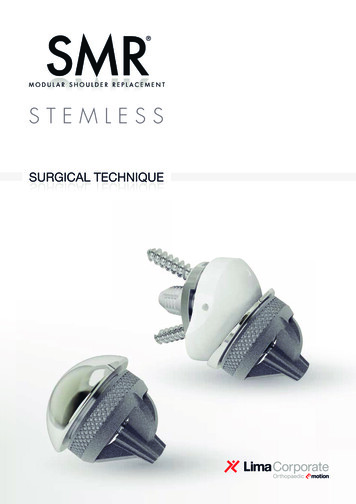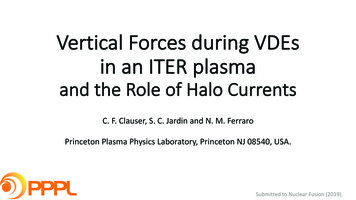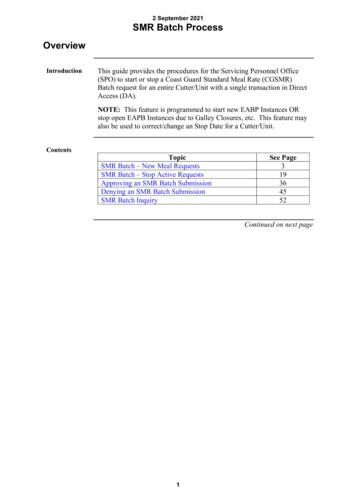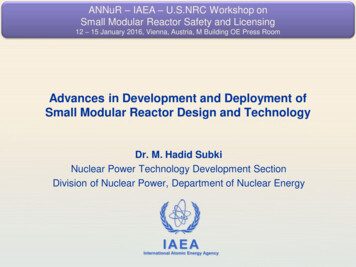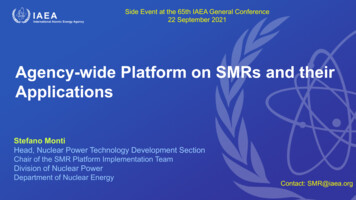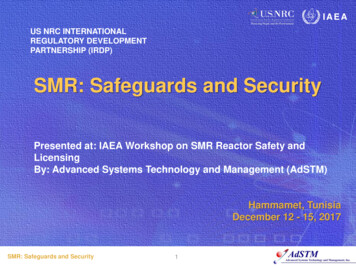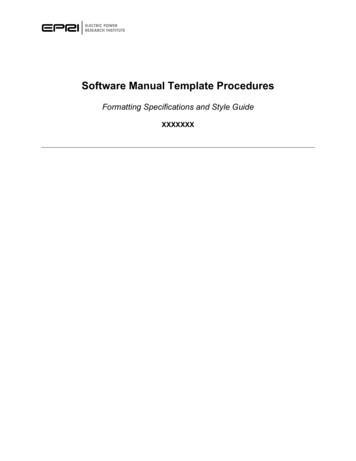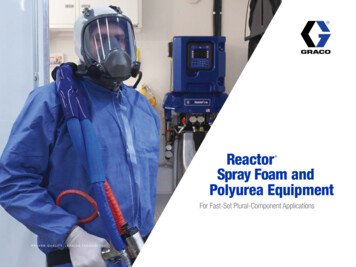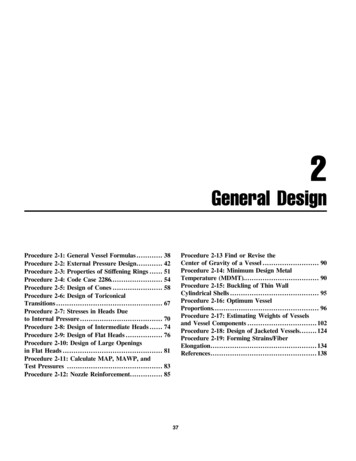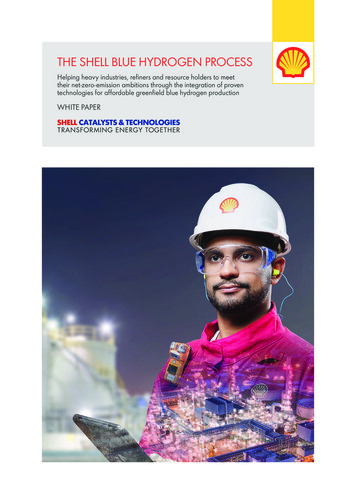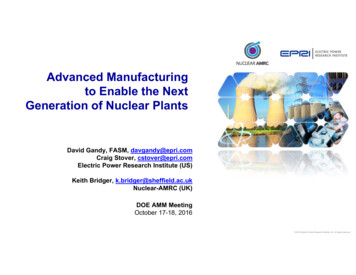
Transcription
Advanced Manufacturingto Enable the NextGeneration of Nuclear PlantsDavid Gandy, FASM, davgandy@epri.comCraig Stover, cstover@epri.comElectric Power Research Institute (US)Keith Bridger, k.bridger@sheffield.ac.ukNuclear-AMRC (UK)DOE AMM MeetingOctober 17-18, 2016 2016 Electric Power Research Institute, Inc. All rights reserved.
Imagine if You Could Produce aReactor Pressure Vessel inUnder 12 Months!2 2016 Electric Power Research Institute, Inc. All rights reserved.
Advanced Manufacturing-Objectives Develop/Demonstrate New Methods forManufacture/ Fabrication of a Reactor PressureVessel (RPV) in 12 months Eliminate 40% from the cost of an SMR RPV,While reducing the Schedule by 18 Months Rapidly Accelerate the Deployment of SMRs200mm Electron Beam Weld3 2016 Electric Power Research Institute, Inc. All rights reserved.
Background EPRI, DOE, and various vendors have been working on a number of advancedmanufacturing technologies over the past 5 years:– EB and RPEB welding– Powder metallurgy-HIP– Diode laser cladding– Dissimilar metal weld joining– Cryogenic machining Industry is looking to develop and demonstrate new technologies for themanufacture/fabrication of SMRs The current project will support work to fabricate specific large scale componentsusing these technologies4 2016 Electric Power Research Institute, Inc. All rights reserved.
Enabling the Next Generation of Nuclear Plants-Scope Manufacture Major Critical Components toAssemble a 2/3-Scale SMR Reactor Pressure Vessel Jointly Funded Collaboration– EPRI, Nuclear-AMRC, DOE, NuScale Power Others– Carpenter, Synertech-PM, TWI, Sheffield Forgemasters, SperkoEngineering, etc. Advanced Processes Employed:– PM/HIP, Electron Beam Welding, Diode Laser Cladding, CryogenicMachining, and Elimination of DMWsWhat Once Took Weeks,We Can Now Do In Hours 5 2016 Electric Power Research Institute, Inc. All rights reserved.Photograph providedcourtesy: NuScalePower
Electron Beam (EB) WeldingWhy EBW? One-pass welding! No filler metal required. EBW can produce welds w/ minimal HAZ TWI, Rolls-Royce, Nuclear-AMRC & EPRIhave demonstrated low volume orreduced pressure EBW on thicksection alloys– Enables field/shop welding!65mm (thick) x 3m length x 1.8m diameterWelding time: 10 minutesPhotograph provided courtesy: TWIElectron Beam Weld1) as-received and2) solution annealedand Q&T conditionsInspection, Costs? Huge savings in welding costs(again, one pass welding) Potential to eliminate in-service inspection!6 2016 Electric Power Research Institute, Inc. All rights reserved.
Powder Metallurgy-Hot Isostatic Pressing (PM-HIP)Why PM-HIP? Near-net shape and complex components(reduces materials cost and machining) Alternate supply route, shorter turn-aroundtimes Considerable EPRI/Industry development overlast 5 years. Ideal for multiple penetration applications(RPV or CNV head) vs expensive forgingsSteam SeparatorInlet SwirlerLarge 316L SS Valve BodyInspection, Costs? Homogeneous--Excellent inspectioncharacteristics Costs roughly equivalent to forging3700 lb BWR nozzle7 2016 Electric Power Research Institute, Inc. All rights reserved.Partial RPV Ring Section
Diode Laser Cladding (DLC)Why DLC? Robotic machine welding High deposition rates Significantly reduces cladding thicknessrequired to 1mm thick Up to 45mm widthInspection, Costs? lbs. (or kgs.) of material required issignificantly reduced since thinner layers canbe applied. No machining after cladding requiredDiode Laser Cladding equipment setup(courtesy of N-ARMC)8 2016 Electric Power Research Institute, Inc. All rights reserved.
Elimination of Dissimilar Metal WeldsHow Do We Eliminate DMWs? PM-HIP has been used to bond dissimilarmetals with nickel-based powder inbetween. Successfully demonstrated A508-to347SS and A508-to-316LSSInspection, Costs? Eliminates need for difficult to inspect weld(s) Metallurgical bond lines are perpendicular tosurface for significantly improved inspection Cost is 60% of welded costs9 2016 Electric Power Research Institute, Inc. All rights reserved.
Advanced MachiningAdvancements Machine Prep RPV ring sections and heads forEBW joining Machine Prep Horizontal and Vertical Weld Joints Boring of steam plenum and CRD penetrations3m x 5m Vertical Turning/Milling Capability (Courtesyof N-AMRC)Costs? Technologies developed by N-ARMC seek 4Xreduction in machining time12m x 5m Horizontal Boring Mill Capability(Courtesy of N-AMRC)10 2016 Electric Power Research Institute, Inc. All rights reserved.
Where Do the Cost & Schedule Savings Come From? Eliminates need to procure forgings well ahead of construction– Often 2-5 years lead-time for forgings; Major components--produced by PM-HIP in 6-12 months– Reactor heads savings anticipated: 2-3M each– Lengthens decision making window Electron Beam Welding can reduce welding time significantly:– For 100mm RPV shell, a reduction from 120 welding/PWHT days to 12-15 welding/PWHT days Diode Laser Cladding can reduce the welding material costs required by 50% PM-HIP provides near-net shaped components and can eliminate 1000s of hoursof machining. Cryogenic Machining can reduce machining time by up to 4X.Eliminate 40% from the Cost of an SMR RPVReduce Manufacturing Schedule by 18 Months11 2016 Electric Power Research Institute, Inc. All rights reserved.
Project Tasks1. Lower Reactor Assembly2. Upper Reactor AssemblyMiddle Reactor Assembly (not included)3A. Thick Section EBW Development3B. Reduce Pressure EBW Development4. Diode Laser Cladding Development5. Elimination of DMWs—for NozzleApplications6. Elimination of In-Service Inspection viaSolution Heat Treatment7. ASME BPVC Code Development8. ORNL Mechanical and MetallurgicalTesting12 2016 Electric Power Research Institute, Inc. All rights reserved.Representative Modelof NuScale PowerReactor Vessel
Task 1—Lower Reactor Assembly(508 materials)1. RPV Lower Head– Manufacture via PM-HIP in two halves– EBW halves together, solution annealed, Q&T– LDC completed lower head– BAM center boss and core supports2. RPV Flange Shell– Manufacture shell and flange via forging– EBW sections together, solution annealed, Q&T– LDC completed flange shell3. Upper RPV Flanged Transition Shell– Manufacture 4 ring sections via PM-HIP and flangevia forging– EBW sections together, solution annealed, Q&T– LDC completed flange shell13 2016 Electric Power Research Institute, Inc. All rights reserved.Representative Modelof NuScale PowerReactor Vessel
Task 2—Upper Reactor Assembly (1)(508 materials)4. RPV Top Head– Manufacture via PM-HIP in two halves– EBW halves together, annealed, Q&T– LDC completed top head5. RPV PZR Shell– Same as Item 2 aboveRepresentative Modelof NuScale PowerReactor VesselCont’d on next slide14 2016 Electric Power Research Institute, Inc. All rights reserved.
Task 2—Upper Reactor Assembly (2)(508 materials)6. Integral Steam Plenum– Manufacture via PM-HIP in two sections– EBW together, annealed, Q&T– LDC completed plenum7. Steam Plenum Access Port Assembly– Manufacture via PM-HIP in two sections– Machine prep– EBW access port assemblies into integralsteam plenum15 2016 Electric Power Research Institute, Inc. All rights reserved.Representative Model ofNuScale Power ReactorVessel
Middle Reactor Assembly--Not Manufactured/Fabricated In Project Upper RPV SG Shell Lower RPV SG Shell Technologies addressed elsewhere inproject (under Tasks 1 & 2)Carbon steel pipe welded with EBWPhoto courtesy of TWI16 2016 Electric Power Research Institute, Inc. All rights reserved.
Tasks 3A and 3B Task 3A. Thick Section EBW Development– Several organizations (NAMRC, EPRI, TWI, RR,UOM) have been developing EBW for thick RPVmaterials– Nuclear-AMRC has a 4.5m x 5.0m x 9m chamberwhich permits a 6m x 3.5m (19.7 x 11.5m) coupon tobe fabricated in the chamber.– 3A will focus on additional process/parameterdevelopment for handling RPV sections(Courtesy of N-AMRC) Task 3B. Reduce Pressure EBWDevelopment (optional task)– Additional development is required for out-of-chamberwelding– TWI has demonstrated capability up to about 3 inches(75mm)– More development will be required to move to 4.375inches (110mm)17 2016 Electric Power Research Institute, Inc. All rights reserved.
Task 4—Diode Laser Cladding Development Develop/demonstrate cladding for:– RPV Shell– Upper and Lower Heads– Nozzles– PlenumTask 5—Elimination of DMWs for Nozzle Applications (optional task) Produce test blocks to demonstrate:– A508-to-690– A508-to-304L Manufacture/demonstrate nozzle-to-safeend (A508-to-690) Manufacture/demonstrate nozzle-to-safeend A508-to-304L18 2016 Electric Power Research Institute, Inc. All rights reserved.
Task 6—Elimination of In-Service Inspection via Solution Heat Treatment Modeling:– flange to RPV shell– circumferential shell weld Local PWHT – safe handling of shells/head Plate Trials– Understand distortion and microstructure– Cladding, EB welds, PWHT, Soln Anneal, Q&T– Inspection Distortion Measurements– Circumferential weld– Weld to join two halves of torispherical head together– Inspection Full Section Heat Treatment– Lower flange shell– Model and solution HT– Distortion measurements19 2016 Electric Power Research Institute, Inc. All rights reserved.Thick section RPEB weld. Courtesy of TWI
Task 7--ASME BPV Code Development Task will focus on working with ASME and EPRIUtility Requirements Document (URD) Example Code Cases/Changes anticipated:– Elimination of periodic ISI for solution HT, quench andtempered EB welds Volumetric upon manufacturing only– Acceptance of 508 using PM-HIP as Code Case forproduction of vessel materials– Inspection criteria for Diode Laser Cladding on RPVmaterials (shells, nozzles, etc)– Reduce Pressure EB welding– Bulk Area Manufacturing20 2016 Electric Power Research Institute, Inc. All rights reserved.
What Are The Critical Gaps ThatMust Be Addressed? (1) EBW must be demonstrated– 4.375-inch (110mm) thick (RPV)– currently demonstrated at 4-inches (100mm) ATLAS HIP facility must be built– to increase HIP size capabilities– up to 3.1m diameter x 5m length– Can manufacture 2/3rds scale coupons today.30mm, 130mm, and 200mm EB welds EBW of SA508 RPV sections– Does a vessel that has been EB welded, solution annealed, and quenched and tempered requiresubsequent in-service inspections?– Is EB really a weld after solution annealing? No filler metal.– Need to demonstrate fracture toughness following solution anneal21 2016 Electric Power Research Institute, Inc. All rights reserved.
What Are The Critical Gaps That Must Be Addressed? (2) Diode Laser Cladding must be demonstrated– Vessels, nozzles, etc.– Robotic cladding up to 90mm wide, but 5mm thick Understand Irradiation Effects on PM-HIP Components– NEUP project for PM-HIP samples are underway– 304L, 316L, SA508, Grade 91, Alloys 625 and 690 Additional development around SA508.– We have demonstrated good fracture toughness and other properties, but we need to developmore understanding here.– Utility Requirements Document modification ASME Code Case Development– PM-HIP of SA508– Elimination of DMWs– EB welding of RPV sections22 2016 Electric Power Research Institute, Inc. All rights reserved.
How Do We Get There?-Strategic Plan Not aimed at First-of-a-Kind Could use ring forgings (or PM-HIPrings). Definitely PM-HIP for top head, bottomhead, plenum caps, and elimination ofDMWs EBW & Solution Anneal eliminatesseveral major shell horizontal weldsWhat Once Took Weeks, WeCan Now Do In Hours 316LN SS End cap forHadron Collider (courtesyMetso)40-inch Large Inconel 625 Impeller(courtesy Synertech PM and GE Oil &Gas)23 2016 Electric Power Research Institute, Inc. All rights reserved.
Applicability of Advanced Manufacturing Processes Multiple SMR Plant Designs ALWR Plant Components GEN IV Designs– multiple nickel-based alloys will be required Ultra-Supercritical Plant Components Supercritical CO2 Plant Components24 2016 Electric Power Research Institute, Inc. All rights reserved.
SummaryUtilizing Adv. Manufacturing/Fabrication Technologies(eg., PM-HIP and Electron Beam Welding),EPRI/Nuclear-AMRC project will: Develop/Demonstrate New Methods for Manufacture/Fabrication of a Reactor Pressure Vessel (RPV) in 12 months Eliminate 40% from the cost of an SMR RPV, Whilereducing the Schedule by 18 Months Rapidly Accelerate the Deployment of SMRs Technologies are applicable across SMRs, ALWRs,and Gen IV units25 2016 Electric Power Research Institute, Inc. All rights reserved.
Together Shaping the Future of Electricity26 2016 Electric Power Research Institute, Inc. All rights reserved.
-5.00mm-3.75mm-2.50mm-1.25mmWCL 1.25mm 2.50mm 3.75mm 5.00mm27 2016 Electric Power Research Institute, Inc. All rights reserved.
WCL of EB Weld vs 5mm distance(following Solution Anneal and Q&T) – 100XMicrostructure 5mm from WCL @ 100XWCL microstructure @ 100X28 2016 Electric Power Research Institute, Inc. All rights reserved.
WCL of EB Weld vs 5mm distance(following Solution Anneal and Q&T) – 500XWCL microstructure @ 500XMicrostructure 5mm from WCL @ 500X29 2016 Electric Power Research Institute, Inc. All rights reserved.
"We choose to go to the moon!. We choose to go tothe moon in this decade and do the other things, notbecause they are easy, but because they are hard,because that goal will serve to organize and measure thebest of our energies and skills, because that challengeis one that we are willing to accept, one we areunwilling to postpone, and one we intend to win."JFK Speech – September 12, 196230 2016 Electric Power Research Institute, Inc. All rights reserved.
Assemble a 2/3-Scale SMR Reactor Pressure Vessel Jointly Funded Collaboration -EPRI, Nuclear-AMRC, DOE, NuScalePower Others -Carpenter, Synertech-PM, TWI, Sheffield Forgemasters, Sperko Engineering, etc. Advanced Processes Employed: -PM/HIP, Electron Beam Welding, Diode Laser Cladding, Cryogenic Machining, and Elimination of DMWs
